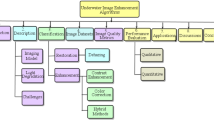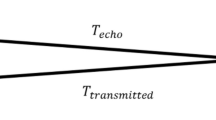Abstract
Marine sonar image noise absorption under water can result in poor image quality, low image resolution and blurred target contour. This paper proposes a systematic framework including underwater image fuzzy preprocessing method, and clustering based on the principal component analysis (PCA) of underwater targets. Underwater images were denoised adopting fast median filtering algorithm with mean acceleration. The fuzzing mathematics were not only developed with the aim of improving the visual quality of underwater sonar images, but also involved in the sonar image segmentation for extracting the target area from the suspicious area. Both the geometric and statistical features were treated as features in PCA algorithm. As demonstrated by the experimental results, visual quality of the sonar image was improved, multi-target threshold segmentation was achieved and multiple targets could be analyzed and clustered for stably tracking AUV.














Similar content being viewed by others
Abbreviations
- \( x_{\text{max} } \) :
-
Maximum gray value of the image
- \( x_{\text{min} } \) :
-
Minimum gray value of the image
- \( f_{ij} \) :
-
Gray value of the pixel located at (ij)
- \( \mu (f_{ij} ) \) :
-
Membership degree of the gray value at pixel (ij)
- averagex(t):
-
Average of x position coordinate of the pixel whose gray value equals to the given threshold t
- averagey(t):
-
Average of y position coordinate of the pixel whose gray value equals to the given threshold t
- \( d_{\text{max} } \) :
-
Maximum distance from the spatial pixel to the average position
- \( f_{\text{max} } \) :
-
Maximum gray value
- \( f_{\text{min} } \) :
-
Minimum gray value
- \( \mu_{0} \) :
-
Average value of the foreground pixels gray value
- \( \mu_{1} \) :
-
Average value of the background pixels gray value
- X :
-
A fuzzy set
- T max :
-
Records the threshold value corresponding to the blur distance \( d_{\text{max} } \)
- \( B(x,y) \) :
-
Binary image
- \( P_{R} \) :
-
Perimeter
- JM:
-
Compactness
- L:
-
Major axis length
- S:
-
Minor axis length
- \( F_{1} \) :
-
The first principal component index
- \( F_{2} \) :
-
Second principal component index
- \( \lambda_{i} \) :
-
Coefficient of the principal component Fi
References
Wang, N., Pan, X.: Path-following of autonomous underactuated ships: a translation–rotation cascade control approach. IEEE/ASME Trans. Mechatron. (2019). https://doi.org/10.1109/TMECH.2019.2932205
Wang, N., Deng, Z.: Finite-time fault estimator based fault-tolerance control for a surface vehicle with input saturations. IEEE Trans. Industr. Inf. (2019). https://doi.org/10.1109/TII.2019.2930471
Kusterbeck, A. W., Charles, P. T., Melde, B. J. Biosensor UUV payload for underwater detection. In: Proceedings of SPIE, pp. 1–8, 2010. http://dx.doi.org/10.1117/12.850317
Qin, H., Chen, H., Sun, Y., et al.: Distributed finite-time fault-tolerant containment control for multiple ocean Bottom Flying node systems with error constraints. Ocean Eng. (2019). https://doi.org/10.1016/j.oceaneng.2019.106341
Qin, H., Chen, H., Sun, Y.: Distributed finite-time fault-tolerant containment control for multiple Ocean Bottom Flying Nodes. J. Franklin Inst. (2019). https://doi.org/10.1016/j.jfranklin.2019.05.034
Qin, H., Yu, X., Zhu, Z., et al.: An expectation-maximization based single-beacon underwater navigation method with unknown ESV. Neurocomputing (2019). https://doi.org/10.1016/j.neucom.2019.10.066
Miller, A., Miller, B., Miller, G.: AUV navigation with seabed acoustic sensing. 2018 Australian & New Zealand Control Conference, pp. 166-171, 2018. https://doi.org/10.1109/anzcc.2018.8606561
Wang, N., Sun, Z., Jiao, Y., et al.: Surge-heading guidance based finite-time path-following of underactuated marine vehicles. IEEE Trans. Veh. Technol. (2019). https://doi.org/10.1109/TVT.2019.2927893
Wang, N., Karimi, H.R.: Successive waypoints tracking of an underactuated surface vehicle. IEEE Trans. Industr. Inf. (2019). https://doi.org/10.1109/TII.2019.2922823
Wang, N., Karimi, H.R., Li, H., et al.: Accurate trajectory tracking of disturbed surface vehicles: a finite-time control approach. IEEE/ASME Trans. Mechatron. 24(3), 1064–1074 (2019). https://doi.org/10.1109/TMECH.2019.2906395
Li, X., Zhang, M.: Underwater color image segmentation method via RGB channel fusion. Opt. Eng. 56(2), 1–13 (2017). https://doi.org/10.1117/1.OE.56.2.023101
Valdenegro-Toro, M: Improving Sonar Image Patch Matching via Deep Learning. In: Proceedings of the European Conference on Mobile Robotics, pp. 1–6, 2017. http://dx.doi.org/10.1109/ECMR.2017.8098701
Andy, M., Acker, T.: Underwater threat detection and tracking using multiple sensors and advanced processing. In: 2016 IEEE International Carnahan Conference on Security Technology, pp. 443–450, 2016. https://doi.org/10.1109/ccst.2016.7815723
Juhwan, K., Cheol, Y. S.: Convolutional neural network-based real-Time ROV detection using forward-looking sonar image. In: 2016 IEEE/OES Autonomous Underwater Vehicles, 10: 396–400, 2016. https://doi.org/10.1109/auv.2016.7778702
Natalia, H., Narcis, P., Sharad, N.: Automatic detection of underwater chain links using a forward-looking sonar. Oceans 8, 392–400 (2013). https://doi.org/10.1109/OCEANS-Bergen.2013.6608106
Wang, F. Q., Zhang, X., Xing, X. F.: The research of underwater acoustic detection system for small AUV,” 5th International Conference on Instrumentation and Measurement, Computer, Communication, and Control, pp. 1828–1831, 2015. https://doi.org/10.1109/imccc.2015.389
Tai, S., Tsai, T., Huang, J.: Underwater image enhancement through depth estimation based on random forest. J. Elect. Imag. 26(6), 0630261 (2015). https://doi.org/10.1117/1.JEI.26.6.063026
L. Carin, G. J. Dobeck, “AUV sonar image processing based on improved pulse coupled neural network model and morphology. In: 8th IEEE International Conference on Control and Automation, pp. 365–369, 2010. https://doi.org/10.1109/icca.2010.5524295
Pezeshki, A., Azimi-Sadjadi, M., Scharf, L., et al.: A canonical correlation-based feature extraction method for underwater target classification. Oceans 1, 29–37 (2002). https://doi.org/10.1109/OCEANS.2002.1193244
Huynh, Q., Cooper, L., Intrator, N., et al.: Classification of underwater mammals using feature extraction based on time-frequency analysis and BCM theory. IEEE Trans. Signal Process. 46(5), 1202–1207 (1997). https://doi.org/10.1109/TFSA.1996.547456
Runkle, R.C., Tardiff, M.F., Anderson, K.K., et al.: Analysis of spectroscopic radiation portal monitor data using principal components analysis. IEEE Trans. Nuclear Science 53(3), 1418–1423 (2006). https://doi.org/10.1109/tns.2006.874883
Chang, C., Du, Q.: Interference and noise-adjusted principal components analysis, IEEE Trans. IEEE Trans. Geosci. Remote Sens. 37(5), 2387–2396 (1999). https://doi.org/10.1109/36.789637
Du, Q., Wei, W., Ma, B., et al.: Hyperspectral image compression and target detection using nonlinear principal component analysis. In: Proceedings of SPIE, pp. 1–7, 2013. https://doi.org/10.1117/12.2022959
Super SeaKing DST. https://www.tritech.co.uk/product/super-seaking-dst-v7. Accessed 12 Sept 2019
Acknowledgements
This research was funded in part by the National Natural Science Foundation of China under Grants (51979057, 51609050), in part by the Research Fund from Science and Technology on Underwater Vehicle Technology (6142215180209), and in part by the Fundamental Research Funds for the Central Universities Facing International Academic Frontier Support Program (3072019CFG0101).
Author information
Authors and Affiliations
Corresponding author
Ethics declarations
Conflict of interest
No potential conflict of interest relevant to this article was reported.
Rights and permissions
About this article
Cite this article
Sheng, M., Tang, S., Wan, L. et al. Fuzzy Preprocessing and Clustering Analysis Method of Underwater Multiple Targets in Forward Looking Sonar Image for AUV Tracking. Int. J. Fuzzy Syst. 22, 1261–1276 (2020). https://doi.org/10.1007/s40815-020-00832-x
Received:
Revised:
Accepted:
Published:
Issue Date:
DOI: https://doi.org/10.1007/s40815-020-00832-x




